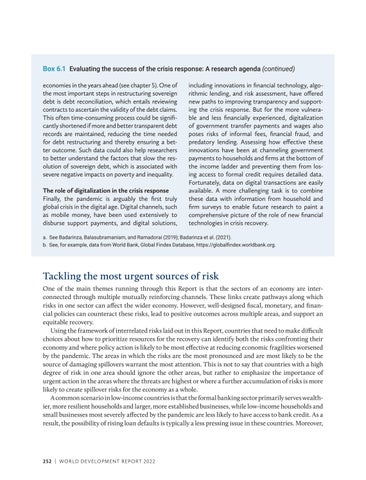Box 6.1 Evaluating the success of the crisis response: A research agenda (continued) economies in the years ahead (see chapter 5). One of the most important steps in restructuring sovereign debt is debt reconciliation, which entails reviewing contracts to ascertain the validity of the debt claims. This often time-consuming process could be significantly shortened if more and better transparent debt records are maintained, reducing the time needed for debt restructuring and thereby ensuring a better outcome. Such data could also help researchers to better understand the factors that slow the resolution of sovereign debt, which is associated with severe negative impacts on poverty and inequality. The role of digitalization in the crisis response Finally, the pandemic is arguably the first truly global crisis in the digital age. Digital channels, such as mobile money, have been used extensively to disburse support payments, and digital solutions,
including innovations in financial technology, algorithmic lending, and risk assessment, have offered new paths to improving transparency and supporting the crisis response. But for the more vulnerable and less financially experienced, digitalization of government transfer payments and wages also poses risks of informal fees, financial fraud, and predatory lending. Assessing how effective these innovations have been at channeling government payments to households and firms at the bottom of the income ladder and preventing them from losing access to formal credit requires detailed data. Fortunately, data on digital transactions are easily available. A more challenging task is to combine these data with information from household and firm surveys to enable future research to paint a comprehensive picture of the role of new financial technologies in crisis recovery.
a. See Badarinza, Balasubramaniam, and Ramadorai (2019); Badarinza et al. (2021). b. See, for example, data from World Bank, Global Findex Database, https://globalfindex.worldbank.org.
Tackling the most urgent sources of risk One of the main themes running through this Report is that the sectors of an economy are inter connected through multiple mutually reinforcing channels. These links create pathways along which risks in one sector can affect the wider economy. However, well-designed fiscal, monetary, and financial policies can counteract these risks, lead to positive outcomes across multiple areas, and support an equitable recovery. Using the framework of interrelated risks laid out in this Report, countries that need to make difficult choices about how to prioritize resources for the recovery can identify both the risks confronting their economy and where policy action is likely to be most effective at reducing economic fragilities worsened by the pandemic. The areas in which the risks are the most pronounced and are most likely to be the source of damaging spillovers warrant the most attention. This is not to say that countries with a high degree of risk in one area should ignore the other areas, but rather to emphasize the importance of urgent action in the areas where the threats are highest or where a further accumulation of risks is more likely to create spillover risks for the economy as a whole. A common scenario in low-income countries is that the formal banking sector primarily serves wealthier, more resilient households and larger, more established businesses, while low-income households and small businesses most severely affected by the pandemic are less likely to have access to bank credit. As a result, the possibility of rising loan defaults is typically a less pressing issue in these countries. Moreover,
252 | WORLD DE VELOPMENT REPORT 2022

